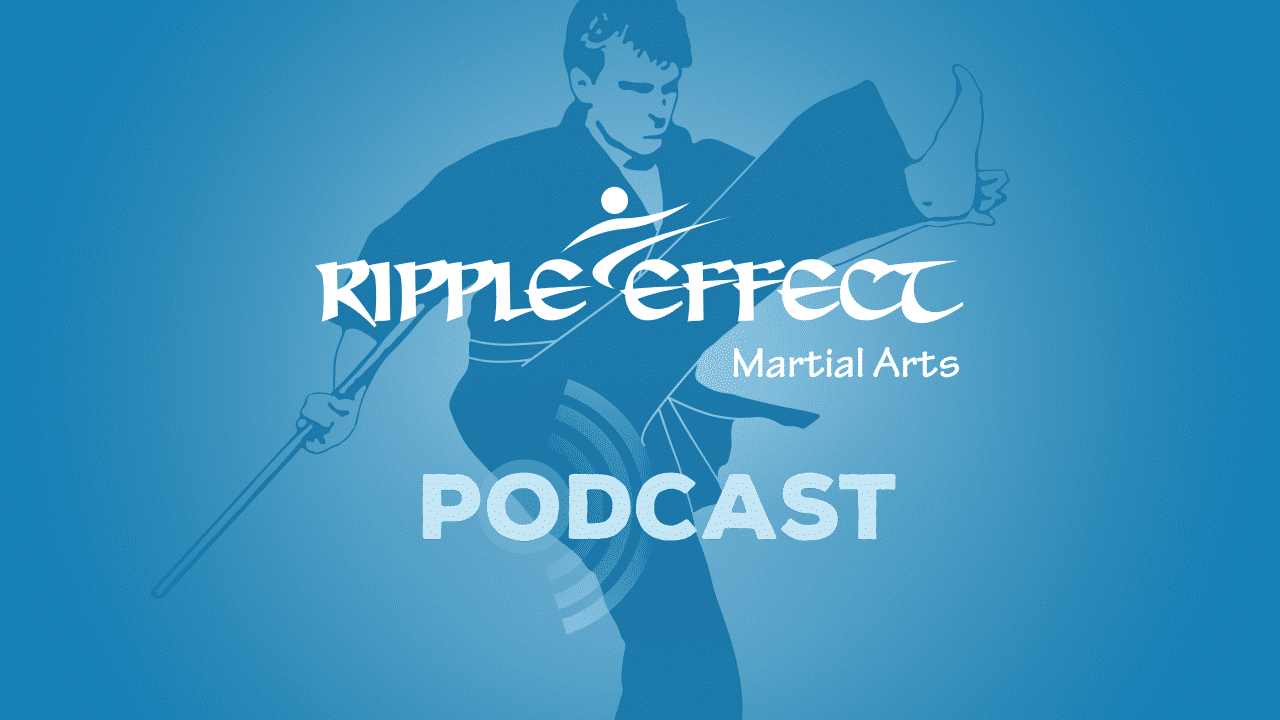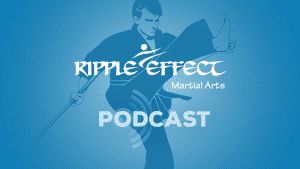When did you start sparring?
I started sparring at my original karate school in upstate New York. They were heavy on the punches (and power) back then.
What was different about the sparring experience at Ripple Effect?
Ripple Effect’s [American Freestyle] taekwondo put a heavy emphasis on kicks. I learned how to use kicks (and dodge them) effectively.
What’s a good approach to sparring, an effective mentality?
You need to approach sparring with confidence, but also with humility. We’re here to build each other up, not beat each down.
Why spar at all? What do you learn?
Martial arts is a contact experience. Not necessarily full contact, at least not all time. Sparring is a way to experience that contact.
When students spar, I want them to understand sparring is about control. Any fool can hit hard. A martial artist is able to hit hard, and to choose not to. I set all students up with the idea that sparring is tag—once you’ve tapped your opponent, you’ve scored the point.
Once your opponent sees your front punch, they’ll move, they’ll respect that move and make a response. Then your job is to capitalize on that response with another strike.
Sparring isn’t personal, that’s another message we teach. Whether you hit or not, whether you win or lose, it’s a powerful thing to get tagged and stand back up, touch gloves, and go for the next point. I want them to come away with the feeling that I can take a hit, and it’s ok. This is a friendly match up. It’s an interesting, fun game to play.
How do you keep sparring safe in the midst of a pandemic?
We’ve thought about this since the pandemic started. How do we let students spar and achieve the goals that they’re looking for? How can we make it safe?
First is that students come in with all their sparring gear on; shin guards, foot pads, chest guards, hand guards. All the warm ups happen with the pads on. Then when it comes time to spar, everyone gets hit with sanitizer. Head gear, mouth guards get adjusted, you get more sanitizer. It takes some getting used to, but it’s for the safety of everyone involved.
We also have a single partner assigned for the whole class, so we’re limiting interactions. And of course class sizes are still limited as well.
How has being an EMT informed your martial arts instruction, specifically safety?
When I was an EMT, we had protocols for how to clean everything—we didn’t have to call and ask anyone how to make sure everything was clean and ready. We were independent in that. On my way to a call, if I needed to, I could pull out my protocols and make sure I was prepared. At karate, we provide an example as instructors but we also give students these protocols and procedures to give them a method to keep themselves and everyone else safe.
Why is important to go slow when you’re learning to spar?
This goes back to your very first karate class. You have to start in slow motion. Otherswise you make mistakes, and you build habits that are very difficult to correct.
Jeff Smith [10th degree Black Belt and famous professional kickboxer] is phenomenally quick and accurate, and he got that way by slow motion practice, slowly building up speed. Speed it up until you can’t do the technique well, reliably any more, then dial it back. It’s a goal setting exercise.
Sparring full-bore right off the bat is sloppy. Sparring slowly and building up the speed is how you build confidence.
What are some things students can practice outside of class, or even alone, to help improve their sparring ability?
One of the best things you can do from home is find a training buddy, Mom, Dad … anyone who can hold a pad for you. Have them pop out the pad while you’re up and moving; hit it with two punches. Pad comes back…. You’re moving, it pops out, you pop the pad with two strikes. This is tactile feedback, and it improves your reaction time, which is huge for sparring.
You can even use a couch cushion (with your parents permission, of course) or a pillow and it gets you punching and kicking toward something real, in response to something real.
What are some principles for distancing when you’re sparring someone else?
Use the pad exercise to explore your own reach, the reach of your feet and your fists, back hand/foot and front hand/foot. You have to have an understanding of how long your arms and your legs are. That’s huge—knowing how far away your opponent is so you know what you can hit, and what can hit you.
For kids this can be tough, because they’re still growing. Those arms and legs gain reach all the time. Sometimes students think they don’t have enough reach, and they do. So that pad holder, stand farther away than you think you need to. You’ll help your student explore their reach.
Listen to the full podcast for more from Mr Wagoner (including how he knew to throw the winning kick that beat me in my black belt test).

